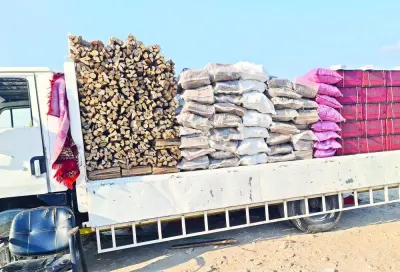* Last winter, between 70 and 100 patients were treated each month at HMC's Emergency Departments for carbon monoxide poisoning
As cooler weather conditions begin to set in, an emergency medicine specialist at Hamad Medical Corporation (HMC) has warned the public about the dangers of burning charcoal and wood inside their homes.
Last winter, between 70 and 100 patients were treated each month at HMC's Emergency Departments for carbon monoxide (CO) poisoning, the corporation said in a statement yesterday.
“CO exposure is responsible for more unintentional poisonings than any other agent, and during the colder months our Emergency Departments sees a significant increase in the number of patients with carbon monoxide positioning,” Dr Galal Saleh al-Essai, an accident and emergency consultant and medical toxicologist at HMC, said.
Carbon monoxide is an odourless, colourless, non-irritating gas produced by the incomplete combustion of carbon-based fuels. CO is found in fumes produced by furnaces, vehicles, portable generators, stoves, lanterns, gas ranges and burning charcoal or wood.
“With the colder season approaching, it is very important for people to be aware of the risk of CO poisoning and to take extra precautions. Some people burn coal or wood inside their homes to stay warm during the winter months and are unaware of the danger and the risk of CO poisoning. Sadly, we see deaths each year as a result of carbon monoxide poisoning and specifically as a result of smoke inhalation from the burning of coal and wood in enclosed areas. And there are other sources of carbon monoxide poisoning that people may be unaware of, including smoking shisha. The charcoal used to heat the tobacco in a hookah gives off potentially toxic amounts of carbon monoxide,” Dr al-Essai said.
Signs and symptoms of carbon monoxide poisoning may include a dull headache, weakness, dizziness, nausea or vomiting, shortness of breath, confusion, blurred vision and loss of consciousness. While anyone is at risk for carbon monoxide poisoning, some population groups are particularly vulnerable, including pregnant women, newborns, young children, the elderly and those with chronic illnesses, such as pulmonary, respiratory, or cardiovascular problems and anaemia.
“CO can build up in enclosed or partially enclosed spaces very quickly. It can be very hard to detect and people who are sleeping can die from CO poisoning before they have symptoms,” Dr al-Essai said.
“Never use a gas-powered generator indoors, including inside a camper or tent. Never burn charcoal or wood indoors, unless it is in an approved indoor wood-burning appliance. Never use a gas range or oven for heating and only use portable gas camp stoves outdoors. Only use fuel-burning appliances such as space heaters, furnaces, charcoal grills, cooking ranges, water heaters, fireplaces, portable generators and wood-burning stoves in properly vented spaces. Speak up when they see something unsafe. It is essential that we all work together as a community to raise awareness about the dangers of CO poisoning,” he added.
Dr al-Essai said carbon monoxide poisoning is so dangerous because the signs and symptoms can be easy to miss. He said most patients treated at the Emergency Departments for CO poisoning present with flu-like symptoms such as a headache, dizziness, nausea and fatigue.
“Depending on the degree and length of exposure, carbon monoxide poisoning can cause permanent brain damage, damage to the heart and death. Many people with mild carbon monoxide poisoning think they have food poisoning or the flu and dismiss the symptoms. Symptoms of carbon monoxide poisoning can start to appear within five minutes of exposure, but lower concentrations may lead to a delay in the onset of symptoms. Anyone who suspects they have symptoms of carbon monoxide poisoning must get into the fresh air immediately and seek emergency medical help,” Dr al-Essai added.
He said it is also important for people to use caution when working with solvents in a closed area. Methylene chloride, a solvent commonly found in paint and varnish removers, can break down (metabolise) into carbon monoxide when inhaled and can cause carbon monoxide poisoning.
Last winter, between 70 and 100 patients were treated each month at HMC's Emergency Departments for carbon monoxide (CO) poisoning, the corporation said in a statement yesterday.
“CO exposure is responsible for more unintentional poisonings than any other agent, and during the colder months our Emergency Departments sees a significant increase in the number of patients with carbon monoxide positioning,” Dr Galal Saleh al-Essai, an accident and emergency consultant and medical toxicologist at HMC, said.
Carbon monoxide is an odourless, colourless, non-irritating gas produced by the incomplete combustion of carbon-based fuels. CO is found in fumes produced by furnaces, vehicles, portable generators, stoves, lanterns, gas ranges and burning charcoal or wood.
“With the colder season approaching, it is very important for people to be aware of the risk of CO poisoning and to take extra precautions. Some people burn coal or wood inside their homes to stay warm during the winter months and are unaware of the danger and the risk of CO poisoning. Sadly, we see deaths each year as a result of carbon monoxide poisoning and specifically as a result of smoke inhalation from the burning of coal and wood in enclosed areas. And there are other sources of carbon monoxide poisoning that people may be unaware of, including smoking shisha. The charcoal used to heat the tobacco in a hookah gives off potentially toxic amounts of carbon monoxide,” Dr al-Essai said.
Signs and symptoms of carbon monoxide poisoning may include a dull headache, weakness, dizziness, nausea or vomiting, shortness of breath, confusion, blurred vision and loss of consciousness. While anyone is at risk for carbon monoxide poisoning, some population groups are particularly vulnerable, including pregnant women, newborns, young children, the elderly and those with chronic illnesses, such as pulmonary, respiratory, or cardiovascular problems and anaemia.
“CO can build up in enclosed or partially enclosed spaces very quickly. It can be very hard to detect and people who are sleeping can die from CO poisoning before they have symptoms,” Dr al-Essai said.
“Never use a gas-powered generator indoors, including inside a camper or tent. Never burn charcoal or wood indoors, unless it is in an approved indoor wood-burning appliance. Never use a gas range or oven for heating and only use portable gas camp stoves outdoors. Only use fuel-burning appliances such as space heaters, furnaces, charcoal grills, cooking ranges, water heaters, fireplaces, portable generators and wood-burning stoves in properly vented spaces. Speak up when they see something unsafe. It is essential that we all work together as a community to raise awareness about the dangers of CO poisoning,” he added.
Dr al-Essai said carbon monoxide poisoning is so dangerous because the signs and symptoms can be easy to miss. He said most patients treated at the Emergency Departments for CO poisoning present with flu-like symptoms such as a headache, dizziness, nausea and fatigue.
“Depending on the degree and length of exposure, carbon monoxide poisoning can cause permanent brain damage, damage to the heart and death. Many people with mild carbon monoxide poisoning think they have food poisoning or the flu and dismiss the symptoms. Symptoms of carbon monoxide poisoning can start to appear within five minutes of exposure, but lower concentrations may lead to a delay in the onset of symptoms. Anyone who suspects they have symptoms of carbon monoxide poisoning must get into the fresh air immediately and seek emergency medical help,” Dr al-Essai added.
He said it is also important for people to use caution when working with solvents in a closed area. Methylene chloride, a solvent commonly found in paint and varnish removers, can break down (metabolise) into carbon monoxide when inhaled and can cause carbon monoxide poisoning.



